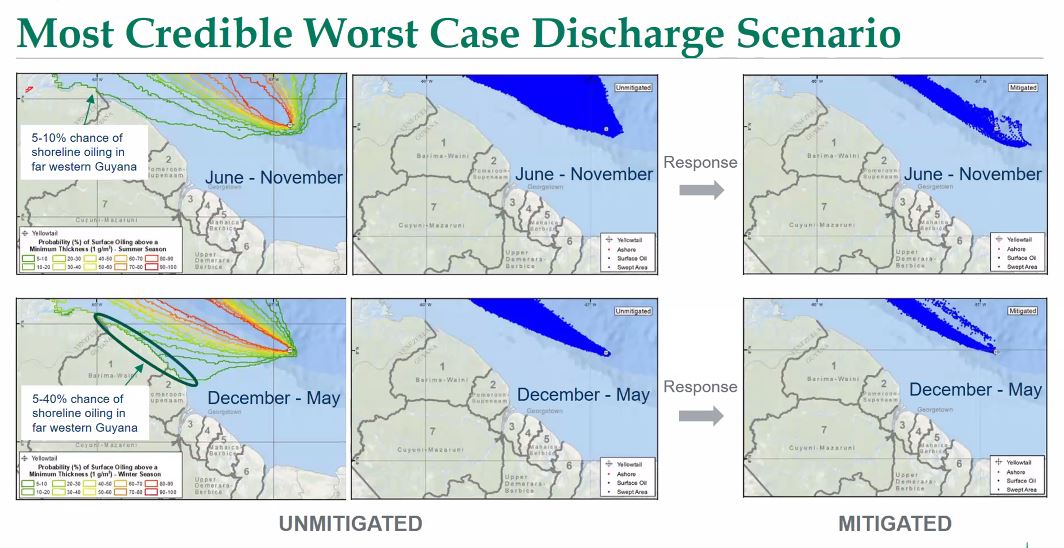Yellowtail, Exxon’s fourth offshore project, gets environmental approval
The Environmental Protection Agency (EPA) gave its permission for ExxonMobil to move ahead with the development of the Yellowtail project in the Stabroek Block offshore Guyana.
An environmental permit was granted for five years to Esso Exploration and Production Guyana Limited (EEPGL)- ExxonMobil’s local affiliate, the EPA said on Friday.
With this permit, the company can now undertake the construction and operation of production facilities. The approval and granting of the permit are in keeping with the Environmental Protection Act Cap 20:05.
The start-up of the Yellowtail project is expected to begin in late 2025 and is anticipated to produce 220,000 barrels of oil per day from a Floating Production Storage and Offloading (FPSO) vessel that would be able to store up to two million barrels.
This project would be the fourth development in the Stabroek Block. Production has already started at the Liza Phase 1 and 2 projects; startup production at Payara is planned for 2024.
The EPA, in a media release, stated that this approval was granted after the EPA considered public inputs during all statutory periods for public consultations and review.

“The EPA also took into consideration the technical review and recommendations from a team of Independent International Experts, and the Environmental Assessment Board (EAB).
“The EAB reviewed and declared the revised [Environmental Impact Statement (EIS)] acceptable and provided recommendations for EPA’s approval as part of the environmental permit,” the release added.
ExxonMobil, through its environmental consultant- the Environmental Resource Management (ERM), applied to the EPA for an environmental permit to operate in the Stabroek Block.
It has since submitted the Environmental Impact Assessment (EIA) and other ancillary documents as part of the process and held public consultations.
At one public consultation, Caribbean activists, fearful of the risk to Caribbean islands from any potential oil spill in Guyanese waters, said there was need for regional talks to iron out their concerns.
Though oil from the Yellowtail well would be produced offshore Guyana, consultants from the ERM acknowledged that an oil spill would impact other Caribbean countries.
Other concerned stakeholders raised questions about insurance for such an unplanned event and even the measures in place to respond to an oil spill.
Last week, however, Vice President Dr. Bharrat Jagdeo assured Guyanese that financial coverage for any mishap is being considered before Guyana approves Yellowtail.
He also defended the government’s emphasis on securing these financial assurances, noting that insurance provisions in the Payara permit and the forthcoming Yellowtail permit are stronger than those issued by the previous government.
And, he disclosed that Guyana and the company are in talks for a parent guarantee that will cover the entire Stabroek Block.
In the media release, the EPA said that the permit “comprehensively addressed all environmental and social safeguards that are reasonably necessary to protect human health and the environment; including implied conditions as provided for in section 13 of the EPA Act.”
Key provisions in the permit, as identified by the EPA, are as follows:
Flaring – Like its predecessors, the Permit strictly prohibits routine flaring and venting, and specifies that flaring is only permissible during commissioning, start-up and special circumstances. The Permit also goes further to maintain payments in instances where flaring is conducted beyond permitted durations.
Oil spill response and financial assurance – Among the notable conditions, the Permit requires EEPGL to procure a Capping Stack to be maintained, tested, and stored in Guyana. A capping stack is a large well closure device that connects to the top of the blowout preventer (BOP) and is capable of sealing off a well. It is a form of modern technology (available post the Gulf of Mexico, Macando incident) to cap a well in event of a loss of well control, and failure of the blowout preventer (BOP).
Additionally, EEPGL must maintain access to at least one (1) overseas subscription service, to allow mobilization of a Capping Stack to the project location. This serves to fortify safety and emergency response efforts since wells would be swiftly capped in the event of a well blow-out.
The Permit also ensures that EEPGL is held liable for all costs associated with clean up, restoration and compensation for any pollution damage which may occur as consequence of the project. EEPGL is also required to have Financial Assurance which includes a combination of Insurance which must “cover well control, and/or clean up and third-party liability on terms that are market standard for the type of coverage”, and a Parent Company/Affiliate Guarantee Agreement which indemnifies and keeps indemnified the EPA and the Government of Guyana in the event EEPGL and its Co-Venturers fail to meet their environmental obligations under the Permit.
Further, the financial assurance provided must be guided by an estimate of the sum of the reasonably credible costs, expenses, and liabilities that may arise from any breaches of this permit. Liabilities are considered to include costs associated with responding to an incident, clean-up and remediation and monitoring.
Monitoring – In seeking to ensure EEPGL meets its obligations to prevent and mitigate environmental harm, the Permit imposes comprehensive requirements for monitoring and management of any impacts affecting biological, physical, and socio-economic resources within the Area of Influence of the project, including targeted and updated environmental baseline studies. The Permit also requires EEPGL to submit safety case information, including a risk assessment prior to drilling and development of wells.
Grievance mechanism – Further, EEPGL is also enjoined to establish and maintain a Grievance Mechanism in keeping with the World Bank’s Approach to Grievance Redress in projects, to ensure that complaints from individuals and communities who may be affected by the project are received and addressed. There is a requirement for reporting
same and what actions were taken to address the grievances to the EPA.







